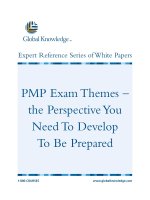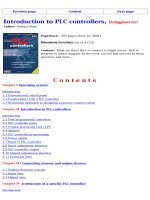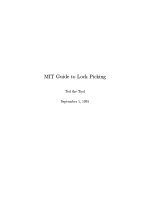Air Pollution -We expect our air to be clean docx
Bạn đang xem bản rút gọn của tài liệu. Xem và tải ngay bản đầy đủ của tài liệu tại đây (5.84 MB, 118 trang )
Air Pollution
Air Pollution
We expect our air to be clean
Donora Smog Disaster
Donora is a borough in Washington County,
Pennsylvania, 20 miles (32 km) south of
Pittsburgh on the Monongahela river
In 1948, Donora suffered the worst air
pollution disaster in the history of the U.S.
Donora Smog Disaster
Beginning on Tuesday, October 26, 1948, emissions
from the town's factories, including fluoride, chloride,
hydrogen sulfide, sulfur dioxide and cadmium oxide,
mixed with soot and ash, were trapped by an air
temperature thermal inversion that shrouded
Donora's 13,000 residents in a deadly smog for five
days
Donora Smog Disaster
Donora at high noon
Donora Smog Disaster
By the time rain cleared the skies on Sunday,
October 31st, 6000 people had been stricken by
the polluted smog and 20 had died
Hundred lived with severe lung disorders for the
rest of their lives
Donora Smog Disaster
In the aftermath of the accident, US Steel
conspired with U.S. Public Health Service
officials to successfully cover up the roll
that pollution played in the tragedy (it was
blamed on the air inversion)
US Steel settled quietly out of court
It took nearly 7 long years,
but the legacy of Donora
was the first landmark
federal clean-air act that
passed in 1955
London & Coale Smoke
The citizens of London suffered for four
centuries under the pall of “coale smoke”
London & Coale Smoke
Some of Claude Monet’s (1840-1926) most famous
paintings are views of smoke-ensnarled London in
1899-1901
London & Coale Smoke
As bad as the smoke was during Victoria-era
London, thanks to smog, the worst was yet to
come
Charring
Cross
Bridge in
1899 by
Monet
The Great London Smog of 1952
The Great Smog, also referred to as the Big
Smoke, befell London starting on December 5th,
1952, and lasted until December 9th
In the weeks that
followed, the medical
services compiled
statistics and found
that the smog had
killed 4,000 people
Another 8,500 died in
the following months
The Great London Smog of 1952
Deaths in most cases were due to respiratory
tract infections from hypoxia, and due to
mechanical obstruction of the air passages by
pus arising from lung infections caused by the
smog
Another 100,000 suffered
chest pains, lung
inflammation, diminished
breathing ability,
damaged respiratory
cells, permanent lung
damage and asthma
The Great London Smog of 1952
Between 1952 and
1956, new regulations
were put in place
restricting the use of
dirty fuels in industry,
banning black smoke
and restricting air
pollution
Air Pollution
In most cases, you cannot see the pollution in
water, groundwater or soil
But air pollution can be seen and smelled by
everybody
The smog in Los Angeles was hard to ignore or
deny
Air Pollution & $
Air pollution is costly, both in terms of money
and health
About $16 billion is spent each year on air
pollution in the U.S.
A reduction of air pollution levels by 50% would
save an estimated $2 billion per year in health
cost
Implicit in the decreased health costs is an
increase in longevity, a decrease in illness and
improvement in the quality of life
Atmosphere Chemistry
The Earth’s atmosphere is primarily composed of
three gases
Nitrogen 78%
Oxygen 21%
Argon 0.93%
And very small amounts of other gases, such as
carbon dioxide (0.03%) and ozone (0.000004%)
It can hold variable amounts of water vapor (0-4%)
Atmosphere Chemistry
Gases cycle through the atmosphere as
they do through other natural reservoirs
Atmosphere Chemistry
And you can describe a
residence time for
gases and particles in
the atmosphere, just as
you can for chemicals
in the oceans
Atmosphere Chemistry
Oxygen
Oxygen has a fairly simple cycle
It is added to the atmosphere by photosynthesis
by plants
It is removed by oxygen breathing organisms, by
reaction with minerals in rocks during weathering
(oxidation) and by combustion
Carbon Dioxide
Carbon dioxide has a complex cycle
Types of Air Pollution
There are two major classes of air pollutants
Gases (primarily oxides of carbon, nitrogen
and sulfur)
Particulates (fine, solid particles, light enough
in weight to be airborne)
Types of Air Pollution
Principal sources of
U.S. air pollutants
Particulate Matter
Particulate matter in the atmosphere includes
soot, smoke and ash from fuel combustion
(mainly coal and wood), dust released during
industrial processes, and other solids from
burning of vegetation (mainly slash & burn)
Most of these are point sources
Estimates of human contribution of particulate
matter in atmosphere range from 35 million to
180 million tons per year
Particulate Matter
90% of the particulate matter in the
atmosphere comes from natural sources,
including volcanic eruptions, dust storms
and natural forest fires
The remaining 10% is caused by human
activity and is concentrated around cities









